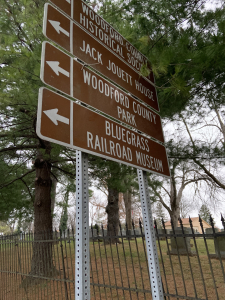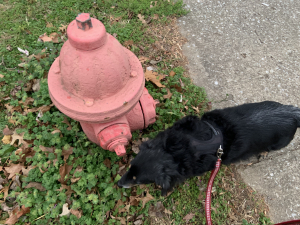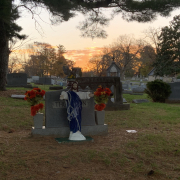I give the dog’s leash a little tug to move him along from the fragrant, faded fire hydrant he’s been examining in exhaustive detail. “C’mon, bud,” I encourage him, “let’s go see Jesus.”
Hearing my words aloud, I realize that these are not routine instructions for your average weekday morning dog walk, so I reflexively spin my head in both directions to see if anyone heard me. There is no one around at 7:05 a.m. on the sidewalk bordering South Main St. on this particular morning, so both my comments and my plan will proceed unnoticed.
It’s only a few steps past the fire hydrant and the street signs guiding tourists to local historical spots to the plot in the city cemetery where I first spied Jesus. He faces the street, ornamenting a grave in the row closest to the leaning old black iron fence that separates the cemetery property from the sidewalk and the busy thoroughfare that bisects the town. Jesus stands beneath towering pines with arms fully extended, robed in blue and white, affixed in his forever stance to…what? Welcome, bless, comfort, maybe all of the above, the thousands of daily passers-by. His gaze is forever directed across the street at a row of the routine fixtures of daily life in any busy community: the brightly lit drive through lanes at the bank branch, the sadly dark Baptist church, silent and quiet in the pandemic, and the corner convenience store, with its brisk flow of plumbing trucks, beer deliveries, workers emerging with donuts and coffee on their way to the day’s tasks.
In the chilly dawn of the fall morning the first time I noticed him, I moved closer to the fence for a better look, wondering at the interesting collage of symbols on the grave. The statue is about three feet tall, and he stands on his own stone pad in front of the gravestone and between two containers of red plastic mums with a pair of concrete angels perched above his head, also adorned with permanent flowers. All important symbols, no doubt, with their own particular significance to the family whose beloved member rests below. I wondered why they stood him facing the raucous South Main traffic flow, instead of the gentle swells of lawn, quiet rolling drives, and ancient trees that dot the peaceful, historic property on the other side of the fence. 
Growing up in the Protestant church and touring through membership in various branches of it as an adult, I have few memories of spiritual icons or religious art. Many Protestant churches, especially older ones, are spare at most in architecture and interior embellishment, perhaps an intentional contrast. As a wide-eyed tourist I’ve richly appreciated the remarkable architecture and artistic icons in some of the world’s great churches—St. Paul’s in London, Notre Dame in Paris, St. Patrick’s in New York come to mind—but even then, I never contemplated (amazingly) what bond may connect spiritual art and spiritual practice. Does the heavenly bandwidth speed increase if you are gazing at a magnificent medieval image of Christ, or a gleaming, ornate gold cross, as you offer your prayers? Do your knees rest more easily, abetting more fervent messaging to the Divine, if the prayer bench is ancient carved rosewood? Why should any of that matter to the soul that seeks answers, that desires to vocalize faith?
The answers to these things are far beyond my own academic experience and clearly differed in the views of experts through history. The discovery of Jesus on South Main nudged me to an intriguing page of Google search results. Why robe Jesus in blue, for example? Britannica’s section on historic iconography reports that blue is considered the color of life. And so on.
For me as a person of faith, there’s never been an established prayer ritual, same time, same place, daily and weekly or however often. Prayer and meditative contemplation run more like a flowing stream, ebbing here and there as the climate requires, higher volume after downpours of sorrow, quietly reflective on the yoga mat, celebratory maybe in the exact moment of an unexpected joy. I can’t recall every pointing these thoughts and offerings at any particular location or thing, until I noticed Jesus on South Main St.
In these bizarre times, when so much that we understand and trust stands on its head, when the entire world is fighting a deadly enemy no one can see, the eyes and ears and heart keep seeking different answers. How do you maintain, indeed re-energize, spiritual connection when our traditions are taken from us, and we make do with “couch church” on the laptop screen, our hymns and prayers echoing only in our own homes?
Somehow, for reasons that elude me but were known to the spiritual pilgrims and artists of centuries past, there is surprising comfort in praying to something as I stand in front of it. And so, on the average morning as we stroll along when the morning light rises in the distance, after the dog has relieved himself with characteristic efficiency, we pause near the old iron fence for a few words to offer Him.
On a very important recent morning, I asked for blessings for our nation. Just yesterday, for the family of a wonderful and giving man who has just been diagnosed with cancer. I’ve asked Him for help for my mom, who suffers depression and more under the pandemic restrictions in senior living. For my daughter, her children, and all the families struggling to maneuver home-based schooling and a work schedule. For my cherished friend who lost both her beloved husband and her job within 60 days. It seems, this year, that the suffering is omnipresent, immeasurable. The dog waits patiently, appearing to understand that when the words end, we will be moving on.
We all worry (so my friends reassure me) that we are getting a little wacky in this ongoing isolation. So, I still find myself hoping I am not overheard by a passing jogger or truck driver stopped at the stoplight, his windows open. Even on a busy street, prayer still seems like a private, personal exercise. But maybe one morning I’ll see a member of the family who put Jesus there, fixed him in position for those passing by, arms outstretched and unmoving through the months, years, and decades. Thanks, I’d like to tell one of them, for turning him to face the street.

